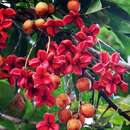pt-BR
nomes no trilho de navegação


Lepiderema is a genus of nine species of trees from the family Sapindaceae. As of November 2013 botanists know of seven species growing naturally in Australia and two species in New Guinea.[1][2][3][4] Published botanical science provides a limited knowledge of the full range of diversity in Australia and especially in New Guinea.[3][4] In New Guinea the two known species have descriptions based each on only a single type specimen collection.[3] Therefore, collection of more specimens and more species is most likely in New Guinea.[3] In Australia they grow in rainforests of the northern half of the east coast side of the Great Dividing Range, from northeastern New South Wales through to northeastern Queensland.[1][2][4][5][6]
In Australia, some species share the name tuckeroo with the closely related genus Cupaniopsis.
The northeastern NSW and southeastern Queensland endemic species L. pulchella has obtained the conservation status of "vulnerable" species by both the Qld and NSW governments.[2][7][8]: 52
Two of the northeastern Queensland endemic species L. hirsuta and L. largiflorens have the Queensland government conservation status of "near threatened" species.[2][8]: 71
This listing was sourced from the Australian Plant Name Index and Australian Plant Census,[1] Flora Malesiana,[3] and Sally T. Reynold's scientific publications.[4]
Lepiderema is a genus of nine species of trees from the family Sapindaceae. As of November 2013 botanists know of seven species growing naturally in Australia and two species in New Guinea. Published botanical science provides a limited knowledge of the full range of diversity in Australia and especially in New Guinea. In New Guinea the two known species have descriptions based each on only a single type specimen collection. Therefore, collection of more specimens and more species is most likely in New Guinea. In Australia they grow in rainforests of the northern half of the east coast side of the Great Dividing Range, from northeastern New South Wales through to northeastern Queensland.
In Australia, some species share the name tuckeroo with the closely related genus Cupaniopsis.
The northeastern NSW and southeastern Queensland endemic species L. pulchella has obtained the conservation status of "vulnerable" species by both the Qld and NSW governments.: 52
Two of the northeastern Queensland endemic species L. hirsuta and L. largiflorens have the Queensland government conservation status of "near threatened" species.: 71
Lepiderema es un género perteneciente a la familia Sapindaceae, con ocho especies de plantas de flores, nativas de Australia y nueva Guinea.
Lepiderema es un género perteneciente a la familia Sapindaceae, con ocho especies de plantas de flores, nativas de Australia y nueva Guinea.
Lepiderema é um género botânico pertencente à família Sapindaceae[1].
Lepiderema é um género botânico pertencente à família Sapindaceae.
«Lepiderema — World Flora Online». www.worldfloraonline.org. Consultado em 19 de agosto de 2020